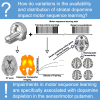Motor learning is modulated by dopamine availability in the sensorimotor putamen
- PMID: 39584157
- PMCID: PMC11582004
- DOI: 10.1093/braincomms/fcae409
Motor learning is modulated by dopamine availability in the sensorimotor putamen
Abstract
Successful motor skill acquisition requires the dynamic interaction of multiple brain regions, with the striatum playing a critical role in this network. Animal studies suggest that dopaminergic mechanisms are involved in the regulation of motor learning-associated striatal plasticity. In humans, however, the contribution of nigrostriatal dopaminergic transmission to motor learning remains elusive beyond its well-characterized role in initiation and fluent execution of movements. In this prospective observational study, we investigated motor sequence learning in individuals who had undergone 123I-N-ω-fluoropropyl-2β-carbomethoxy-3β-(4-iodophenyl)nortropane single-photon emission computed tomography for the differential diagnosis of Parkinson's disease (n = 41) and age-matched healthy controls (n = 20). We found that striatal dopamine transporter depletion exhibited distinct spatial patterns that were associated with impairments in motor sequence learning and the manifestation of Parkinsonian motor symptoms, respectively. Specifically, significant associations between striatal dopamine transporter depletion and impairments in motor sequence learning were confined to posterior putaminal regions, whereas significant associations of striatal dopamine transporter depletion with Parkinsonian motor symptom severity showed a widespread spatial pattern across the entire striatal volume with an anterior maximum. Normative functional connectivity analysis revealed that both behavioural domains shared largely overlapping connectivity patterns with the basal ganglia and supplementary motor area. However, apart from connectivity with more posterior parts of the supplementary motor area, significant functional connectivity with primary motor cortical areas was only present for striatal dopamine transporter availability-related modulation of online motor learning. Our findings indicate that striatal dopaminergic signalling plays a specific role in motor sequence learning beyond its influence on mere motor execution, implicating learning-related sensorimotor striatum recruitment and cortico-striatal plasticity as dopamine-dependent mechanisms.
Keywords: Parkinson's disease; dopamine; dopamine transporter; motor learning; striatum.
© The Author(s) 2024. Published by Oxford University Press on behalf of the Guarantors of Brain.
Conflict of interest statement
S.H. received speakers honoraria and consultant fees from GE HealthCare, O.S. received grants from Life Molecular Imaging (LMI), J.-J.R. received speakers honoraria from GE HealthCare. All other authors report no competing interests that might be perceived to have influenced the results and/or discussion reported in this paper.
Figures






References
-
- Walker MP, Brakefield T, Hobson JA, Stickgold R. Dissociable stages of human memory consolidation and reconsolidation. Nature. 2003;425(6958):616–620. - PubMed
-
- King BR, Hoedlmoser K, Hirschauer F, Dolfen N, Albouy G. Sleeping on the motor engram: The multifaceted nature of sleep-related motor memory consolidation. Neurosci Biobehav Rev. 2017;80:1–22. - PubMed
-
- Albouy G, King BR, Maquet P, Doyon J. Hippocampus and striatum: Dynamics and interaction during acquisition and sleep-related motor sequence memory consolidation. Hippocampus. 2013;23(11):985–1004. - PubMed
LinkOut - more resources
Full Text Sources
